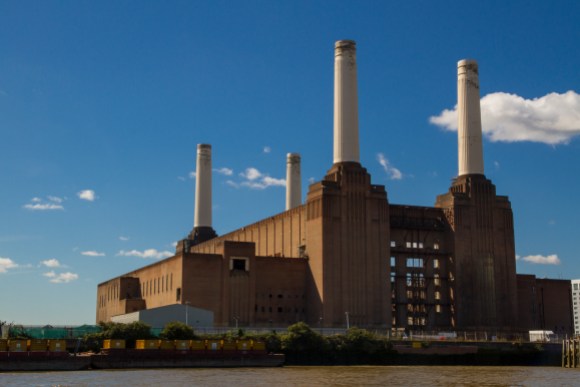
You gotta be crazy, you gotta have a real need
You gotta sleep on your toes, and when you’re on the street
You gotta be able to pick out the easy meat with your eyes closed
So begins the first verse of “Dogs,” a song by progressive rock icon Pink Floyd from their album Animals.
The cover of this album, the visuals that greeted every prospective buyer in record stores around Europe and the United States, featured the now-iconic Battersea Power Station with a forty-foot long inflatable pig floating above it.
The band ran into problems when a gust of wind carried the pig miles away, landing in a farmer’s field, but the resulting album cover was memorable enough to receive a cameo appearance during the opening ceremony of the 2012 Olympics.
This factoid is just one of many covered in Wikipedia’s “good” article on the power station, a quality marker given when an article meets six criteria. Most recently, editors have updated it to include information on Apple’s new London headquarters, which will be located on the site; approximately 1,400 Apple employees will eventually work from there.
The article was nominated for good article status by Wikipedia editor Fintan264, who called the power station “iconic and special”—although in large part only because it is the only station of its type still extant.
| “ | In the 1940s and 1950s, the ‘brick cathedral’ was the go-to design style of electricity generating stations in the UK. That time period also marked the nationalisation of the UK electricity industry and the establishment of the Central Electricity Generating Board. It was a time when electricity was being rolled out to everyone across the country, coinciding with the government of Clement Attlee and his building of a welfare state.” The electricity was generated in these enormous, beautifully designed cathedrals, which in my opinion complimented the British landscape perfectly; modern temples to worship a new sort of power. Personally I don’t think there’s anything particularly special about Battersea, other than it was designed by GG Scott and in London, and so sort of ended up the poster boy of the brick cathedrals. As far as I know, it is now the sole remaining example of the style—which makes it very special! |
” |
Fintan has worked on a plethora of power stations around the UK, including Lemington, Blyth, and Stella. The latter is perhaps the most important, as it is what kindled Fintan’s interest in power stations.
| “ | My interest sprung from having Stella power station, a defunct brick cathedral station, on my doorstep growing up. There was something about the way it looked in the sun, sitting in the Tyne valley, that was really pleasing to me as a kid. Its demolition in 1996-97 was one of my strongest childhood memories, and is still something I’m disappointed about. | ” |
All in all, over 600 editors have made 1230 edits to the article in its fourteen years of existence. Created with 501 words by editor Maury Markowitz in October 2002, the article is now more than ten times larger, at 5,169 words.
Ed Erhart, Editorial Associate
Wikimedia Foundation

Can you help us translate this article?
In order for this article to reach as many people as possible we would like your help. Can you translate this article to get the message out?
Start translation